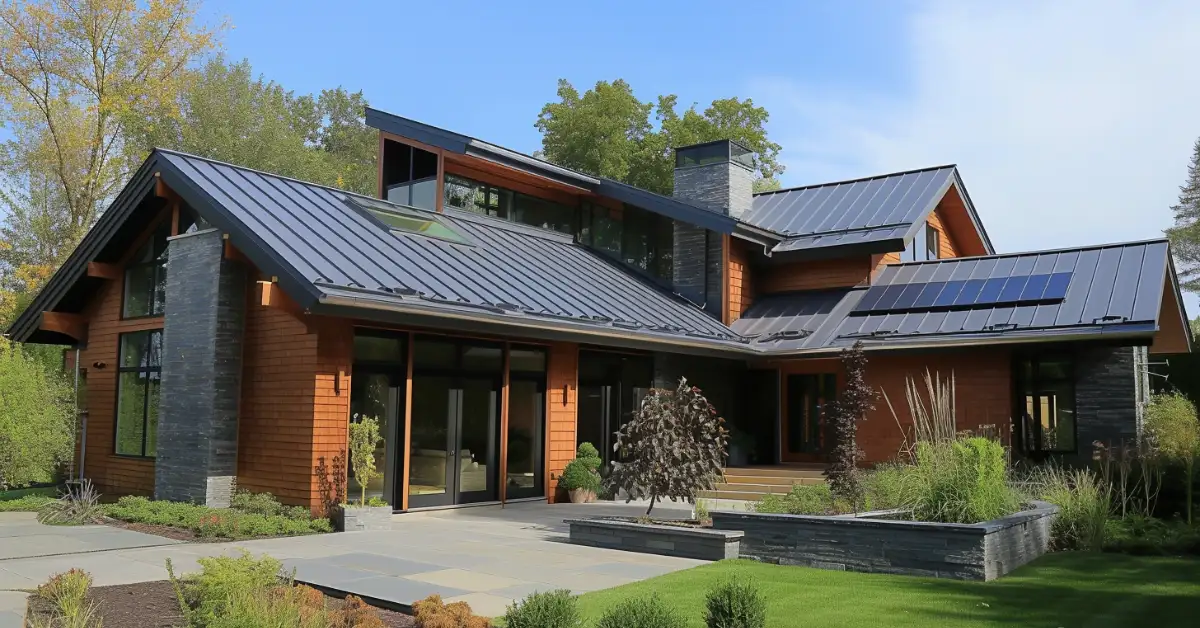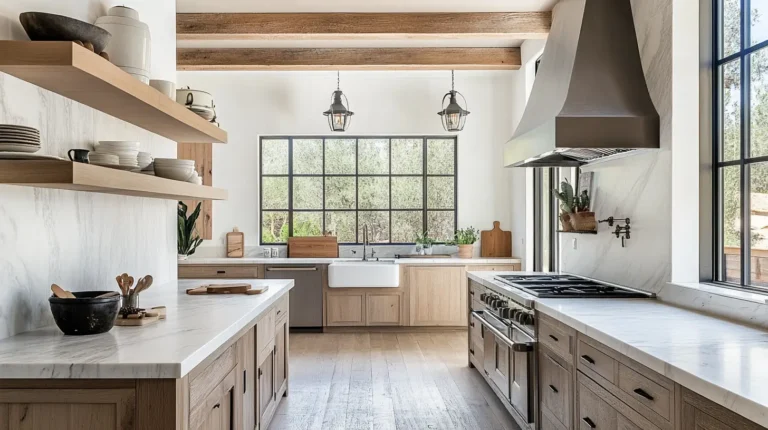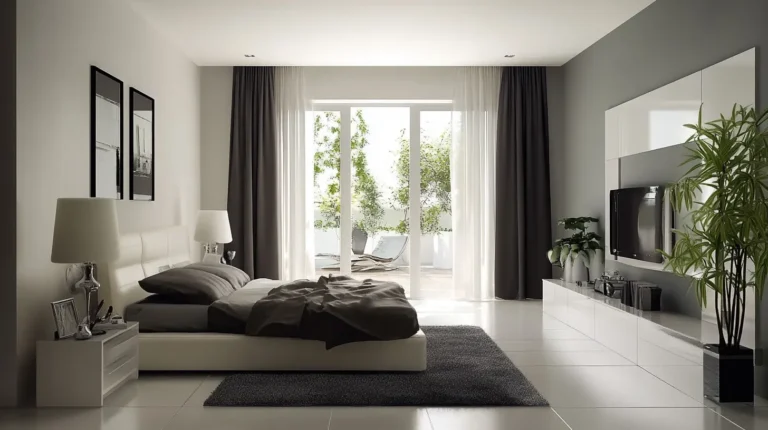Explore the latest in modern roofing to enhance your home’s efficiency and style. With advancements in technology and a focus on sustainability, today’s roofing options offer a blend of durability, energy savings, and aesthetic variety. Make an informed choice from eco-friendly materials to solar-integrated roofs to meet your architectural needs and environmental values. Get the protection your home deserves while minimizing your carbon footprint.
What Defines Modern Roofing?
Here is all in short!
| Characteristic | Description |
|---|---|
| Materials | Utilizes advanced materials like cool roofing, solar tiles, and green roofs. |
| Design | Incorporates sleek, minimalist designs with an emphasis on clean lines and functional aesthetics. |
| Energy Efficiency | Focuses on reducing energy costs with materials reflective of sun’s rays and improved insulation properties. |
| Sustainability | Includes eco-friendly options like recyclable materials and designs that support vegetation. |
| Durability | Engages stronger, more resilient construction able to withstand extreme weather conditions. |
| Technology Integration | Implements innovations such as integrated solar panels and smart roofing technology. |
As we examine modern roofing, it’s important to recognize that our current options are more adaptable and responsive to our needs than ever before. We’re empowered with choices that not only align with our aesthetic desires but also contribute positively to our environment and wallet. Whether it’s through energy-efficient metal roofing or the benefits of a green roof, modern roofing is an exciting, ever-evolving field.

Near the ending I’ll show you the best timberline lifetime shingles!
Roofing Materials Overview
When we discuss modern roofing, it’s essential to consider the variety of materials available that cater to durability, aesthetic preferences, and environmental concerns.
Asphalt and Composition Shingles
Asphalt shingles are perhaps the most prevalent roofing material in the market; they’re cost-effective and work well in various climates. Composition shingles, a subtype of asphalt shingles, are reinforced with fiberglass or organic materials, adding resilience and longevity. These types of roofing materials are favorites among homeowners due to their balance between cost and performance.

Metal Roofing Variants
Metal roofs are a step up when it comes to durability and weather resistance. Available in materials like aluminum and steel, metal roofing is a stout choice that can handle extreme weather conditions. Variants include standing seam metal roofs and metal shingles, both offering sleek design options that reflect natural light and can help reduce energy costs.

Sustainable Options: Green and Solar Roofs
For those of us looking to make a positive environmental impact, green roof systems are a lush alternative. They’re not only visually appealing but also enhance air quality and provide natural insulation. Additionally, integrating solar technology into roofing materials presents a forward-thinking approach, with options like BiPV solar tile roofs turning your home into an energy-generating powerhouse, staying eco-friendly while cutting down on electricity bills. These sustainable options not only conserve energy but also push our homes towards a greener future.

Roof Designs and Styles
When we look at a house, one of the first things we notice is the roof, which significantly impacts the home’s curb appeal. The right roof design can transform the appearance of your entire home.

Traditional Forms: Gable and Hip Roofs
Gable roofs are easily recognized by their triangular shape, providing a classic aesthetic that has been beloved for centuries. This traditional form is not only appealing but also effective at shedding water and snow. On the other hand, hip roofs have slopes on all four sides, which come together at the top to form a ridge. They offer excellent stability and resistance to wind.
- Gable Roof: Classic shape, adds traditional charm.
- Hip Roof: Four sloped sides, ensure durability.
Innovative Designs: Butterfly and Skillion Roofs
Moving away from traditional styles, we find the butterfly roof. This roof is marked by two tandem pieces angled down toward the center, resembling the wings of a butterfly. Not only does this design allow for larger windows and more natural light, but it also creates a modern appearance. Similarly, the skillion roof, with its single, sloping surface, offers a contemporary look that stands out from conventional designs.
- Butterfly Roof: Central Valley, modern flair.
- Skillion Roof: Single slope, bold aesthetic.

How To Roof any House
When we talk about roofing a house, it’s crucial to consider the architectural style and the specific needs that come with each design. Whether you’re dealing with a townhouse or a beach house, the right roof not only protects your home but also complements its aesthetic.
Modern Townhouse
Modern townhouses often feature flat or low-pitched roofs. Our priority here should be ensuring a seamless, watertight surface, often achieved with materials like EPDM or TPO, which provide durability and a sleek finish.

Modern Lake House
For a lake house, we’d suggest a roof with reflective properties to combat the intense sunlight often found in such open areas. Metal roofs can be perfect here, offering longevity and energy efficiency with their reflective panels.

Modern Log Cabin
A traditional log cabin may get a modern twist with a roof that features large overhangs to protect the logs. Using metal in a dark color can blend rustic charm with contemporary style while providing fire resistance.

Modern Beach House
The key to beach houses is resisting the harsh maritime climate. A corrosion-resistant metal roof or high-grade asphalt shingles that can withstand salt spray and high winds will be our go-to options.

Modern Craftsmanhouse
Our Craftsman homes often include gabled roofs with a moderate to steep pitch. Timberline HDZ shingles can match the character while ensuring peak performance in various weather conditions.

Modern Barnhouse
For barnhouse designs, which typically have simple, large roof structures, we’d look at standing seam metal roofs. This choice promotes rain and snow shedding while giving a nod to traditional barn aesthetics.

Contemporary Mountain Homes
For Contemporary Mountain Homes, a steeply pitched roof works best for us. Considerations for heavy snow load and insulation are critical, with options like stone-coated steel to provide both style and substance.

Small Contemporary House
For our Small Contemporary Houses, we want to maximize space; a skillion or shed roof can be an aesthetically pleasing and practical choice, allowing for higher ceilings and an airier interior.

Contemporary Mediterranean House
Mediterranean house styles require tiles, often terra cotta, for an authentic look. However, in a modern twist, concrete or synthetic tiles can offer the style without the weight and maintenance issues.

80s Contemporary House
The unique features of an 80s contemporary house, like large windows or irregular shapes, demand custom solutions. Using shingles that blend well with the natural surroundings would be ideal for maintaining the design’s integrity.

70s Contemporary House
Our approach for a 70s contemporary house would involve restoring the original charm with updated materials. For example, composite shingles can mimic the wood shake roofs that were popular during the era.

Contemporary Modern Tudor House
Steep gable roofs are the signature of Tudor houses, and we’d maintain this with an emphasis on enhancing the curb appeal. A combination of slate or imitation slate can deliver both looks and longevity.

Contemporary Farmhouse
For this timeless design, we aim for a roof that’s as functional as it is beautiful. Standing seam metal roofs or asphalt shingle roofs in neutral tones like gray or beige will harmonize with the farmhouse’s straightforward style.

While roofing materials and methods vary greatly depending on the style of the house, we always focus on quality installation and materials suited to the environment and style of the dwelling. Our approach ensures that each house has the roof it not only needs but deserves.
Roofing for Various Structures
When we explore roofing options, we consider the specific needs of different types of structures. Each building requires tailor-made solutions, whether it’s a spacious agricultural barn or a modern commercial high-rise in Southern California.
Agricultural Buildings: Barns and Sheds
- Barns: These structures often employ gambrel roofs, which provide extra storage space and better withstand heavy snowfall.
- Sheds: A simpler structure like a shed usually opts for flat roofs or low-slope roofs, maximizing space and minimizing construction costs.

Residential and Commercial Roofing
- Residential: Homes often feature a mansard roof, offering extra living space and a timeless aesthetic.
- Commercial: In bustling areas like Southern California, commercial buildings frequently use durable and cost-effective flat roofs, conducive to HVAC installation and maintenance.

Installation and Maintenance
When we talk about roofing, the aspects of installation and maintenance are crucial for ensuring our roof has a long life span and robust durability. A proper installation and ongoing maintenance plan will address key elements such as longevity, insulation, and protection against environmental factors.
Longevity and Durability Factors
The lifespan of a roof can vary significantly based on materials and environmental conditions. Here’s what we need to consider:
- Materials: The choice of materials has a substantial impact. For instance, metal roofs are known for their durability, often lasting 40-70 years, whereas asphalt shingles typically have a lifespan of 15-30 years.
- Quality of Installation: A poorly installed roof might fail much earlier than expected, even with high-quality materials. Ensure that installation is done by professionals and includes the necessary fire-resistant materials to increase longevity.
- Environmental Factors: Areas that experience severe weather, such as high winds or hail, require roofing materials designed to withstand these conditions to avoid premature wear and damage.
Insulation and Ventilation Essentials
Proper insulation and ventilation are key to maintaining a roof’s integrity and the comfort of the home beneath it.
- Underlayment: Quality underlayment plays a critical role in insulation and as a moisture barrier, supporting the roof’s durability.
- Ventilation: Appropriate attic ventilation is critical to prevent moisture build-up and mitigate temperature extremes that can cause materials to expand and contract excessively.
- Regular Inspections: Maintaining insulation and ventilation systems through regular inspections can prevent costly repairs and extend the life of the roof.
Each element of a roofing system works together, and we must give each the attention it deserves—from the underlayment that acts as a secondary moisture barrier to the maintenance that ensures longevity. We recommend that homeowners stay proactive about their roofing installation and upkeep to maximize the benefits and protect their investment.

Cost Considerations
When we talk about getting a new roof, we know that the price can vary widely. Our aim is to balance the initial investment with long-term savings and benefits.
Affordability vs. Premium Options
Opting for an affordable roofing material is tempting. It often means spending less upfront. However, premium options, although more expensive, can offer enhanced durability and style. The lifetime cost of a roof shouldn’t be judged solely by the initial price tag. For example, metal roofing, while pricier per square foot, may outlast asphalt shingles, resulting in a lower cost over time.
Long-Term Savings through Energy Efficiency
Investing in energy-efficient roofing materials can lead to significant long-term savings. A reflective or “cool” roof can reduce heat absorption, which means less energy is required for air conditioning. These roofs can be surprisingly lightweight too. Over the lifespan of your roof, this energy efficiency can offset the upfront costs, making it a savvy choice for both our wallets and the environment.
FAQ – Modern Roofing
What is modern roofing?
Modern roofing includes innovative materials like composite shingles, green roofs, and solar tiles, offering sustainability, energy efficiency, and advanced aesthetics.
What are most modern roofs made with?
Most modern roofs are made with materials such as asphalt shingles, metal roofing, and composite tiles, which are popular for their durability, cost-effectiveness, and versatility.
What is the latest roofing material?
The latest roofing materials include self-healing and self-cleaning roofs, which can repair minor damages and stay clean without maintenance, and impact-resistant shingles, designed for areas with extreme weather conditions.
What is the professional name for a roofer?
The professional name for a roofer can vary, but they are often referred to as roofing contractors or roof mechanics. Roofing professionals may also have specific titles based on their skill level and certifications, such as journeyman or master roofer.
If you enjoyed our blog post on “Modern Roofing,” we would love to hear from you! Please feel free to share your thoughts and experiences in the comment section below.
If you want to keep reading more from us, have a look at these articles.





